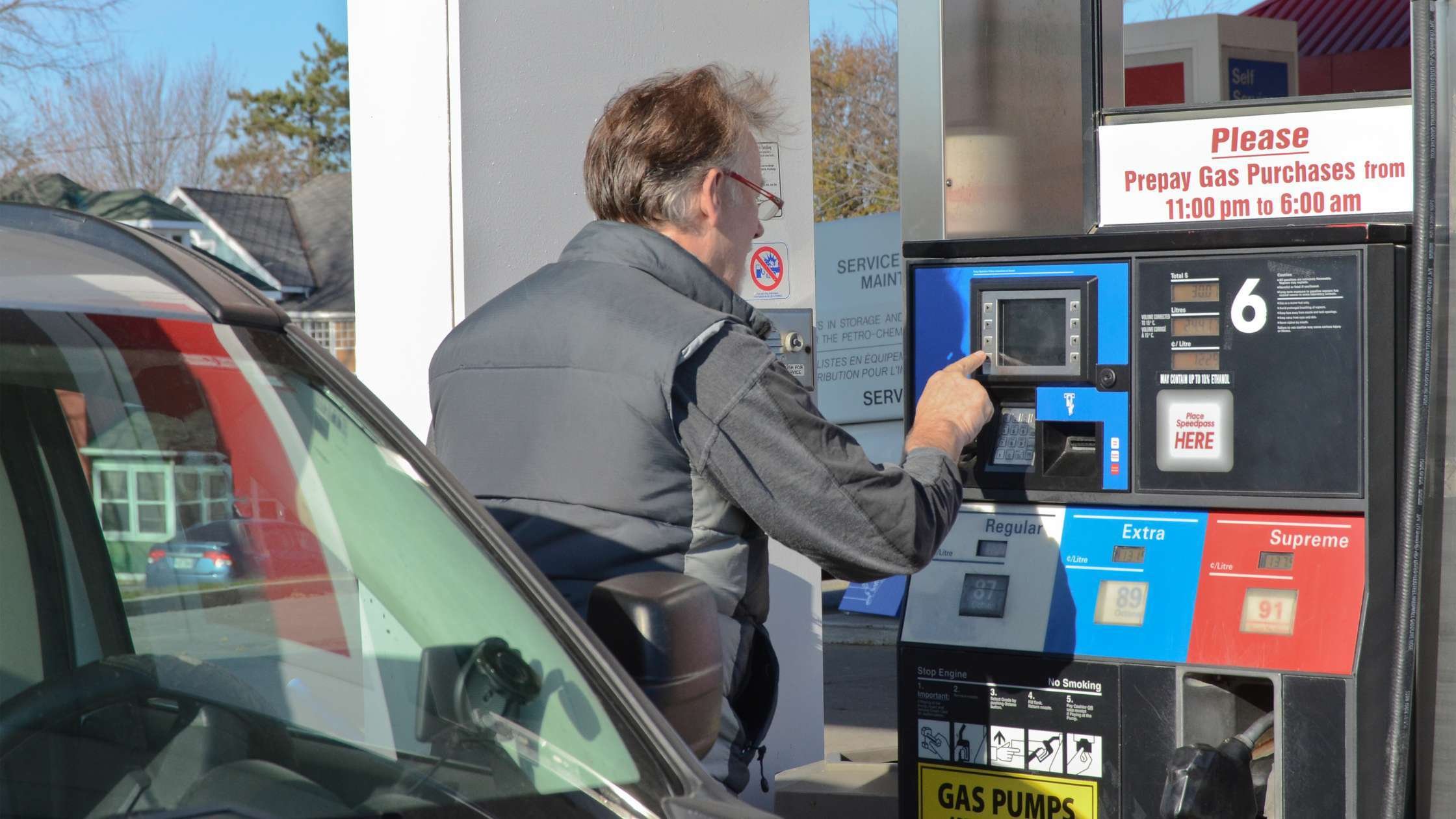
Fuel is one of the biggest operating costs for fleets, which makes managing it effectively a top priority for business owners. That’s where a fleet fuel card program comes in. These programs are designed to simplify how companies pay for fuel, monitor spending, and control costs, all while giving drivers a convenient way to fuel on the road.
Whether you’re running a handful of service vehicles or a nationwide fleet, the right fuel card program can help you set purchase limits, prevent misuse, simplify reporting, unlock fuel discounts, and identify tax savings. In this guide, we’ll explain how fuel card programs work, outline the key benefits for businesses, and help you choose the right type of program for your fleet.
Table of Contents
- What is a fleet fuel card program?
- Fleet fuel card program benefits for businesses
- Different types of fuel card programs
- How to choose a fleet fuel card program
What Is a Fleet Fuel Card Program?
A fleet fuel card program is a payment and expense management system designed to help businesses with vehicle fleets control fuel spending. Instead of using cash or regular credit cards that allow unrestricted spending, drivers use dedicated fuel cards with built-in controls that limit purchases to fuel and maintenance only. This gives fleet managers greater visibility, tighter control, and easier oversight of fuel expenses.
Fleet Fuel Card Program Benefits for Businesses
1. Gain Control Over Fleet Fuel Spending
Unlike regular debit or credit cards, fuel cards are built with spending controls that limit what drivers can purchase. Managers can set individual card limits and monitor activity in real time, to minimize the risk of misuse or theft. Here are some examples of how you can control, monitor, and protect your fuel expense with a fuel card.
Card Limits
- Driver or vehicle cards: Cards can be assigned by driver name or vehicle description. If assigned by vehicle, you have the option to use specific PINs for each driver to identify who was responsible for each fuel transaction.
- Fuel only: While fuel and maintenance is an option with some programs, if certain drivers don’t need that payment flexibility, cards can be restricted to fuel purchases only.
- Fuel type: Some programs even enable managers to control which fuel product is purchased (e.g., unleaded, midgrade, premium, diesel, dyed diesel) to prevent employee misuse.
- Day and time restrictions: Set authorized fueling times and days for each card. If some drivers don’t work over the weekend, for example, you can restrict those cards for use Monday to Friday.
- Transaction limits: Set the number of transactions (purchases) per day that drivers need.
- Gallon and dollar limits: Depending on the program you choose, some offer gallon limits per transaction to match vehicle tank capacity. Other programs allow managers to set daily, weekly, and monthly dollar limits to control spending.
Driver Monitoring
- Online access: Most programs provide customers with online access to transactions and invoices. Customers can log into their fuel card portal whenever they need to review driver activity and download transactions, invoices or reports.
- Odometer entry: Requiring drivers to input the odometer reading of the vehicle at the pump enables fleet managers to track MPG (miles per gallon) and CPM (cost per mile). Any unusual MPG or CPM calculation signals possible misuse or perhaps vehicle maintenance issues.
- Email alerts: If you’re worried that purchase limits might be too strict, or want an extra layer of oversight, email alerts are a great solution. These alerts don’t block transactions, but they notify you by email whenever a card is used outside your set parameters. This keeps you informed in real time and allows you to quickly follow up with drivers to address issues and reinforce fueling policies.
Fraud Protection
Along with spending limits and transaction monitoring, most fuel card programs include fraud protection to help keep your account secure. Some providers include it for free, while others may charge a small fee, so it’s worth confirming with your vendor. Although card skimming at fuel pumps is uncommon, it can happen with any payment card. That’s why it’s important to choose a fuel card program that includes fraud monitoring tools and a solid reimbursement policy to protect your business from unauthorized transactions.
2. Access Detailed Fuel Reports for Easier Accounting
Another important benefit of a fuel card program is data and reporting. Credit and debit cards only collect Level 1 purchase data which includes amount, store name, and date for each transaction. With a fuel card, you'll receive Level 3 data which includes date, time, location, driver, vehicle, odometer entry, fuel product, gallons, price per gallon, federal and state taxes, and total amount for every card transaction. This data is organized into fuel reports that help simplify fuel expense and compliance reporting. Here are some examples:
Fuel Card Reports
- Fuel usage by driver and vehicle
- Fuel expense reports
- IFTA fuel report
- Summary of transactions by division, department, job number, GL code, or product
- Fuel tax refunds
3. Fuel Up Easily at Convenient Locations Nationwide
Fuel at Gas Stations and Truck Stops
Fuel card programs vary in network size based on the type of card you choose. For instance, over-the-road (OTR) fuel cards are typically limited to major truck stops since they’re built for long-haul trucking fleets. Universal fuel cards, on the other hand, offer far broader coverage, allowing drivers to fuel at nearly any gas station or truck stop that accepts credit cards.
Access Commercial Fuel Stations
Some fuel card programs include access to commercial fuel stations, stations designed specifically for fleet vehicles rather than the general public. These sites are open 24/7 and built to handle large trucks with ease, offering wide lanes, high-speed dispensers, and satellite pumps for faster fill ups. Unlike retail stations, which can be cramped or limit truck access, commercial sites give drivers the space and convenience they need to fuel efficiently and stay on schedule.
4. Save Money with Built-In Discounts and Tax Exemptions
Cost-Plus Pricing
If your fuel card program includes access to commercial fueling sites, you can take advantage of cost-plus fuel card pricing. Unlike retail pricing, which is set by individual gas stations, cost-plus pricing is tied to wholesale market rates, often resulting in significant savings depending on fuel market conditions. Some programs even let customers check daily wholesale prices for unleaded and diesel online, making it easy to track and manage fuel costs.
Low-Cost Brand Choice
Universal fuel card programs give fleets the flexibility to fuel at nearly any gas station or truck stop that accepts credit cards. This makes fueling convenient for drivers while helping businesses save on costs. With so many options available, fleets aren’t limited to higher priced stations, drivers can easily compare prices and choose the most affordable locations.
Identify Fuel Tax Exemptions
Businesses that use fuel for off road equipment, farm vehicles, or in certain exempt industries aren’t required to pay road taxes, but they still pay them at the pump. To fix this, the IRS and many state agencies allow companies to file for a fuel tax credit, giving them a refund on the taxes they paid for fuel used in nontaxable operations.
The challenge with filing for a fuel tax refund is that you need to report the exact number of gallons for each type of nontaxable fuel purchased, and credit cards don’t capture that information. Fuel cards, however, make it easy. Since fleet fuel cards record gallons, fuel type, and vehicle details with every transaction, you can quickly identify tax exempt purchases and simplify your refund filing process.
Different Types of Fuel Card Programs
When comparing fuel card programs, it’s important to know that there are three main types, each designed to meet the needs of different fleet operations. Here’s a breakdown of the primary fuel card categories:
Universal Fuel Cards
Universal fuel cards are accepted at most gas stations and truck stops, giving your drivers the flexibility to fuel almost anywhere. They’re a great fit for fleets of any size, vehicle type, or industry operating across broad geographic areas. To compare universal fuel card options, check out the 5 Best Universal Fuel Cards for Business in 2025.
Cardlock Fuel Cards
Cardlock fuel cards offer tighter controls and deeper discounts at commercial fueling sites, making them ideal for fleets that operate on local or regional routes. The two major cardlock networks in the U.S. are CFN and Pacific Pride. To see how they compare, check out the CFN vs. Pacific Pride comparison guide.
Over-The-Road (OTR) Fuel Cards
Built for long-haul trucking fleets, OTR cards are accepted primarily at major truck stops and offer deeper discounts at those locations. They also cover common over-the-road expenses like showers, lodging, and truck repairs.
To compare fuel cards from all categories, check out the 10 Best Fuel Cards for Business [2025]. This guide compares acceptance, discounts, fees, and features for the top business fuel cards to help you find the best fuel card program for your fleet.
How to Choose a Fleet Fuel Card Program
Step 1: Choose a Fuel Card that Is Accepted at the Stations You Use.
Begin by reviewing your recent fuel receipts or transaction reports to see which stations your drivers use most often. Then, compare fuel card programs to find the ones that offer the best fuel card discounts and terms at those locations.
Step 2: Evaluate Fuel Card Fees.
Review each card’s fee schedule closely to understand the true monthly cost for your fleet. Most providers list their fees on their application or website, so you can see potential charges upfront. If a company doesn’t clearly share this information, consider it a red flag.
Step 3: Read Customer Reviews.
Reading third-party fuel card reviews is one of the best ways to get a real sense of what it’s like to work with a fuel card provider. Customer feedback can reveal the quality of support, common pain points, and the advantages other businesses have seen from using the program.
Step 4: Demo the Fuel Card Portal.
Your online fuel card portal is where you’ll manage cards, track transactions, and pull reports, so it’s important to make sure it’s easy to use and fits your needs. Before signing up, ask for a demo or take a self-guided tour to see how the portal actually works.
Step 5: Make Sure You Get Fraud Coverage.
Fraud protection is often overlooked until it’s too late. Before choosing a fuel card, review each provider’s fraud protection and reimbursement policies to make sure you are covered for fraud.
Manage Your Fuel Expenses with P-Fleet's Fuel Card Programs
Whether your drivers fuel at gas stations, truck stops, or commercial cardlock sites, P-Fleet’s fuel card programs make it easy to track every transaction, control spending, and simplify reporting. With customizable spend controls, you can decide how much fuel each card can purchase, when, and how often. Set limits by driver or vehicle, restrict purchases to fuel only, or lock fueling to certain days or times. Real-time transaction monitoring and alerts help you stay on top of spending and catch issues before they become costly.
Every purchase made with a P-Fleet fuel card captures Level 3 data, including driver, vehicle, odometer, gallons, fuel type, and price per gallon, so you'll get detailed reports for accounting, tax filing, and compliance. Whether your business needs the broad acceptance of a universal Voyager card or the deeper discounts and controls of a CFN cardlock program, P-Fleet has an option for your routes and fueling needs.





